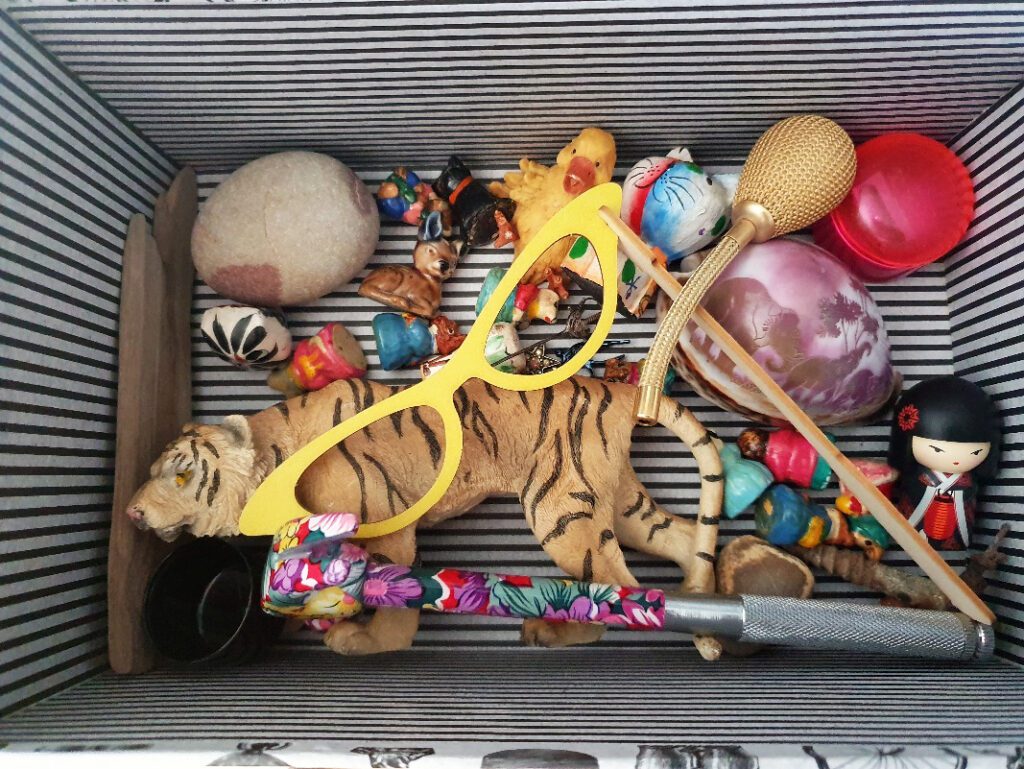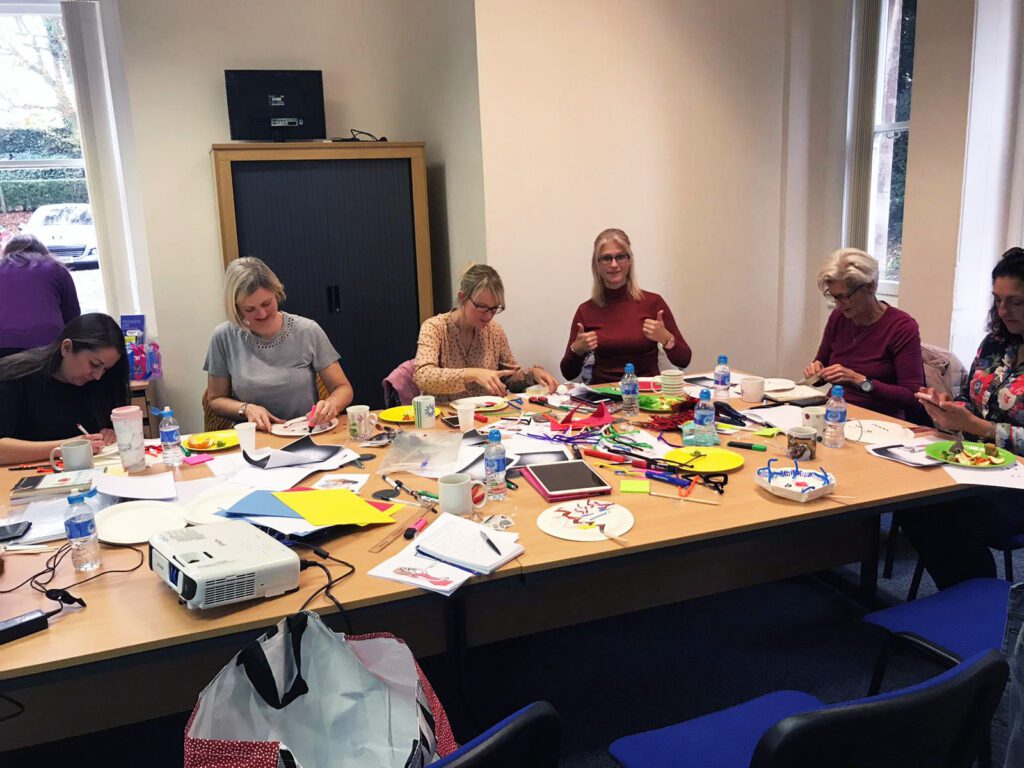Beyond words – creative play in supervision
My recommendation to both supervisors and supervisees would be to try using creative play in supervision–it can nudge you beyond your comfort zone, extend and deepen your learning, and ultimately develop your professional practice.
Supervision offers the supervisee a safe, boundaried, and confidential space in which to discuss with their supervisor the challenges, issues, and emotions they experience in their everyday practice. However, as a supervisee it can sometimes be difficult to put in to words the experience or scenario you want to discuss with your supervisor. Alternatively, you may describe the situation adequately and yet still feel unable to get to the nub of the matter, or you may think you need a deeper, more fine-grained understanding of what was happening for you. This is where your supervisor can invite you to engage in creative play.
Creative play is a term used to describe a very wide range of methods and interventions that can be utilised within the supervision process. It is a way of examining issues from a different perspective and allows us to break away from the constraints a spoken (or signed) language can place on us. Creativity engages us in exploration and refers not to artistic talent, but to the ability to be spontaneous and use our imagination (Schuck & Wood 2011). There are a variety of tools that a supervisor can use to help the supervisee work in a more visual, playful, and creative way, for example the use of metaphor, asking the supervisee to draw their dilemma or scenario on flip chart paper, using puppets to play out the issue they want to discuss, or engaging in role play.
How does this work in practice? I might ask a supervisee to use a metaphor to describe the issue or dilemma they have brought to the session. A question of ‘how did you feel in this situation, can you visualise what was happening’ might bring the response ‘as if I was wading through quicksand’. I can use the image that the supervisee has given me to draw out more information, asking questions such as ‘what did the quicksand feel like?’, ‘what does the quicksand represent for you?’ and ‘how would you like to get out of the quicksand?’. The supervisee might respond by saying they want someone to throw them a rope or that they want to get out themselves, without any help. These responses will then form the basis of further discussion.
Alternatively, I could ask the supervisee if they would like to model their scenario by choosing items from my box of found objects. The supervisee can select items which represent the people involved in their situation or pick an object which represents how they felt at the time. A supervisee might choose a shell, and use this to describe how they feel they have a hard outer casing, but on the inside they are soft and vulnerable. We can then go on to explore in more depth what this means for them in relation to the scenario they are describing. The supervisor does not have to have a box of objects trouvés with them, they may ask the supervisee to select items that are on hand in the room. The important thing is that the supervisee is encouraged to be creative and can derive sufficient meaning from the object(s) they chose.

I frequently encourage supervisees to work visually, for example using flip chart paper to draw an outline of a scenario. The way the supervisee represents the scene can reveal a lot of information which might have been difficult to extract otherwise- the proximity of participants to each other, the layout of the room, the way in which the protagonist or antagonist is shown to be larger or smaller than other characters. All these details will bring to light new and different information.
Creative play can also be used in supervision workshops. During a workshop on shame resilience I expanded on a suggestion from Sanderson (2015) and asked participants to create a mask to represent their feelings when they felt shamed. A paper plate formed the base of the mask and participants then used a range of materials (pipe cleaners, glitter, coloured pens, tinsel etc.) to create their ‘shame face’. This process allowed them to be playful, but at the same time created a powerful and serious representation of their shame experience.


A note of caution. Creative play isn’t for everyone. Some supervisors may feel uncomfortable and/or unconfident in using it. As a supervisor, inviting a supervisee to join in a creative play exercise can feel like a huge risk. I often worry about not being able to ‘make sense’ of what the supervisee creates and then remind myself to trust in the process, observe and to ask questions about what I notice. Some supervisees will not want to engage in creative play. It shouldn’t be foisted upon them, and must not be used randomly, without regard as to its appropriateness. Supervisees can feel exposed and vulnerable by the process of representing their scenario visually, or by acting it out. It is therefore crucial that creative play takes place in a safe environment, and within agreed boundaries. Clear guidelines about what the supervisee can expect are essential (Schuck & Wood 2011). Additionally, the supervisor must be appropriately trained, qualified, and sufficiently skilled to contain the session and ‘hold’ the supervisee.
Finally, and crucially, creative play is not about ‘getting right’, neither for supervisor nor supervisee*. It is a process which enables all parties to view a situation through a different lens. It gives the supervisee the freedom to be spontaneous and to experiment. The outcomes of the creative play exercise may be instantaneously clear to the supervisee, but it also may not be revealed during the session, overnight or even over the next 6 months. However, a new perspective or a shift in thinking may occur over time, or the intervention may open new possibilities to the supervisee when they next experience the same situation or a similar problem. My recommendation to both supervisors and supervisees would be to try using creative play in supervision- it can nudge you beyond your comfort zone, extend and deepen your learning, and ultimately develop your professional practice.
*I would like to thank both Cathy Davey (MBACP Senior Accredited) and Elaine Wiley (Psychotherapist/Trainer) for their input, guidance and wise words in steering me on the road to creative play.
References
Sanderson, C. (2015). Counselling skills for working with shame. London: Jessica Kingsley Publishers.
Schuck, C. & Wood, J. (2011). Inspiring Creative Supervision. London: Jessica Kingsley Publishers.
